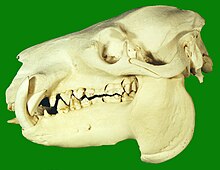Tusk

When tusks are highly trained, rootless, constantly renewable teeth in the upper jaw of certain mammals called, far from the jaw sticking out of an animal. These can be incisors as well as canines . There is no fixed definition of the tusks. Tusks are found in different groups of animals.
Elephants
The tusks of elephants and their extinct relatives ( mammoths , mammoths (or real mastodons), gomphotheries, etc.) are extremely elongated and outwardly displaced incisors of the upper jaw (in some gomphotheries also of the lower jaw ). The largest tusk of an elephant is 3.49 m long (measured by the outer curvature), originally from Zaire and owned by the New York Zoological Society in the Bronx Zoo ; The elephant Hesperoloxodon antiquus germanicus , who lived about 2 million years ago, had the longest tusk from prehistoric times, which is 5 m long . The heaviest tusk comes from Dahomey ( Benin ), weighs 117 kg and was exhibited at the Paris World Exhibition in 1900 ; the heaviest fossil tusk weighs 150 kg with a circumference of 89 cm and a length of 3.58 m and belonged to a mammoth species.
The tusks of Asian elephants are generally smaller than those of African ones . Elephant tusks are the main source of ivory .
Narwhal, walrus
The long, twisted tusk of the narwhal is a reshaped canine tooth ( caninus ). Probably the largest example is in the German Leather Museum in Offenbach am Main . While the length is usually 2 m, this tooth brings it to 2.74 m. The narwhal tooth was mistaken for the horn of a unicorn in the Middle Ages and early modern times and is therefore called the ainkhürn . The walrus' tusks are also formed by the upper canine teeth.
Web links
swell
- ↑ a b Guinness Book of Records 2002, Hoffmann and Campe, ISBN 3896810057
- ↑ a b Guinness Book of Records 1992, Ullstein, ISBN 3550077505
